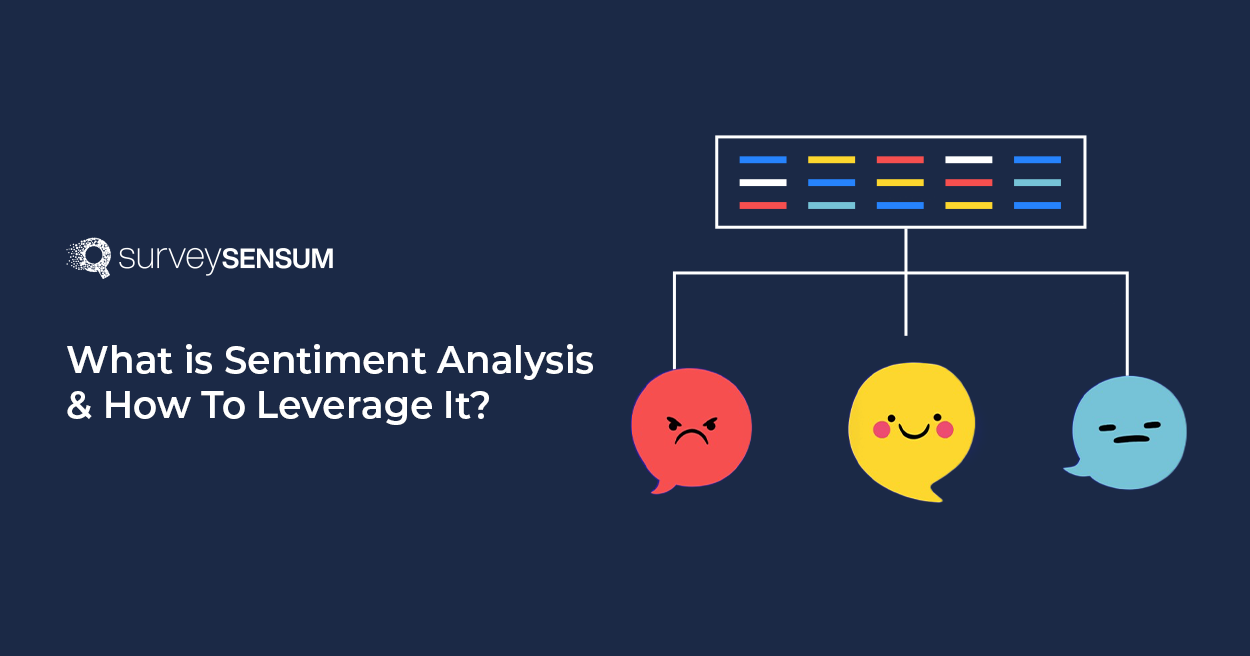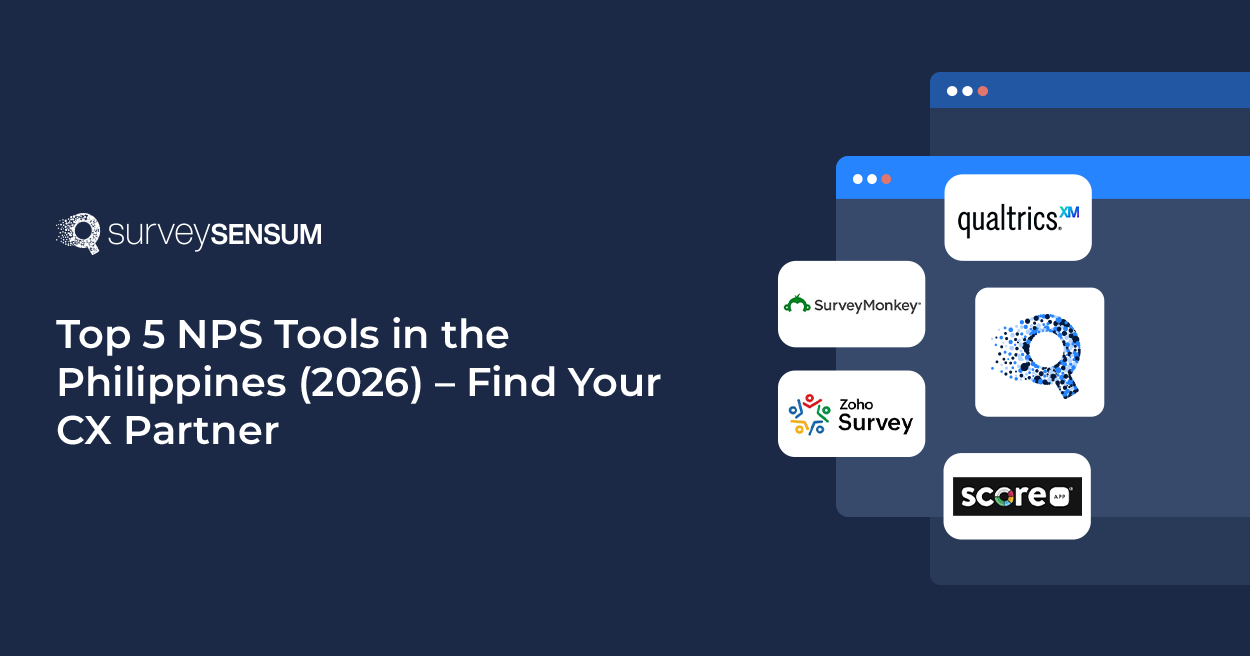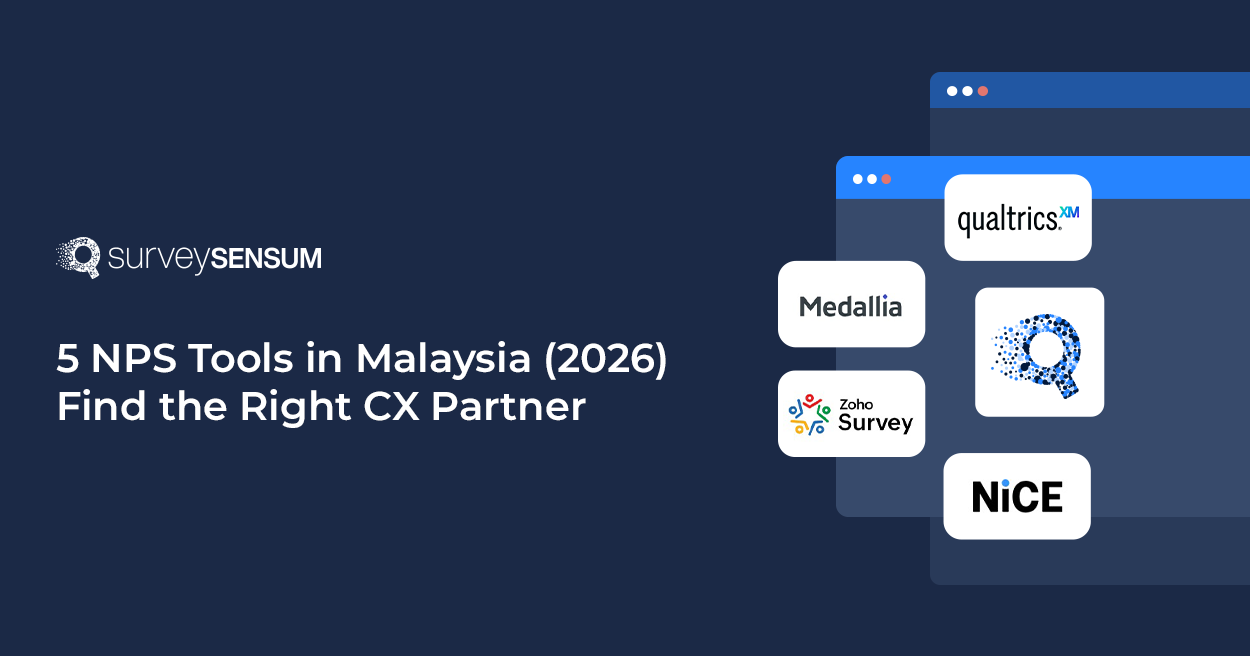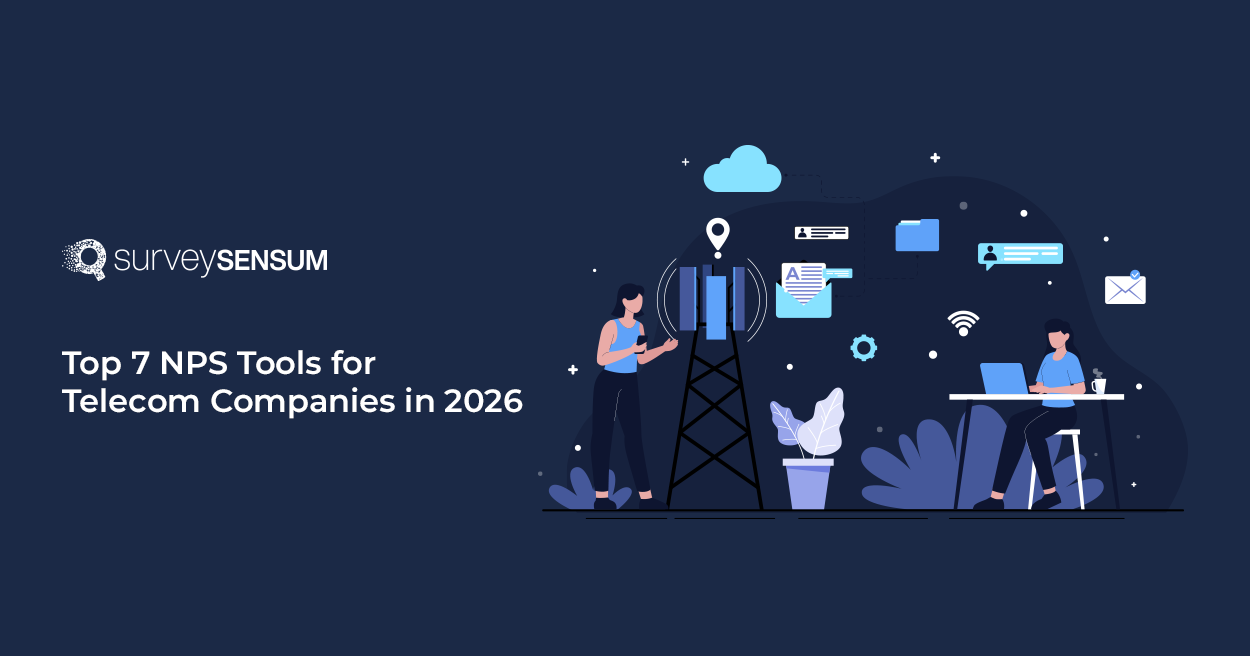

From social media reviews to survey responses, customer data is everywhere. But here’s the real question: are you making the most of it?
With the right AI text analysis tools and techniques, analyzing your survey data can reveal not just what your customers are saying, but how they truly feel about your products, services, and brand as a whole. That’s where sentiment analysis comes in – turning raw feedback into actionable insights.
So, is it worth the investment? Let’s dive in and explore.
What is Sentiment Analysis?

Sentiment analysis is the process of analyzing open-ended feedback using AI technologies like natural language processing, machine learning, and text analytics. It is part of a great umbrella of text mining called text analysis. By identifying and categorizing emotions expressed in text, sentiment analysis assigns a score to each clause based on the emotion expressed in the feedback— for example, +1 for positive sentiment and -1 for negative sentiment.
The core advantage of sentiment analysis is that it can handle large volumes of omnichannel data consistently and accurately. The ability to process massive amounts of data consistently makes sentiment analysis an essential tool for gaining deeper insights into customer opinions and behavior.
However, it can be a long process with several steps to ensure its effectiveness, so is it worth it? Let’s find out.
What is Sentiment Analysis Used for?
The real advantage of using an AI-enabled tool to categorize customer feedback isn’t just that it simplifies the process. The true value emerges when it’s applied at scale, especially when dealing with large volumes of data that require accurate analysis.
For example, you just launched a new line of matte sunscreens for your skincare brand and you got a huge amount of responses across multiple social media channels like Twitter, Instagram, etc. Now, you can read one or maybe five comments, but reading hundreds every day is tiring and unproductive work and to forget is prone to human error.
Not only that, this type of manual analysis also leads to bias coming from the person going through these comments as they might have certain views that might color the way they are interpreting the comment. Also, their judgment might change from time to time depending on their mood, emotions, etc.
So, it’s better to let text analytics tools take care of this task through sentiment analysis, and you worry about how you will put that sentiment into action, and for that, you need to understand how the sentiment analysis system adds value to your analysis.
Why is Sentiment Analysis Important For Your Business?
Although the list of sentiment analysis applications is endless, there are some solid applications that are mainstream today.
1. Tracking Customer Sentiment Over Time
In September 2019, Nike released an ad featuring the controversial National Football League quarterback Colin Kaepernick. Kaepernick became a hot topic of discussion in America when he, like many other footballers, knelt during the national anthem to protest against police brutality.
Nike’s announcement that Colin would be one of the athletes helping commemorate the 30th anniversary of the brand’s iconic slogan took America by storm. Angry customers who were upset with Colin’s ‘kneeling’ took to Twitter to show their dissent. The hashtag #justburnit soon became a viral trend. Sentiment analysis shows that Nike’s net sentiment for the month nosedived.
However, on the flip side, despite the negativity, Nike’s sales resulted in a 31% jump from the controversial ad. According to 4C Insights, Nike’s social media mentions jumped by 1678%, while that of Kaepernick spiked 362,280%.
Needless to say, these figures would have been impossible to track if not for sentiment analysis. Without sentiment analysis, it would have been easy for anyone to make a wrong judgment that the ad was a blunder while the reality was the contrary.
2. Enabling Real-Time Reputation Management
Managing your brand’s reputation isn’t just about tracking comments on various social media channels, it goes beyond that. While social media monitoring restricts itself to social media websites, brand mentions encompass the entire web, including news articles, blogs, press releases, and so on.
Similar to social media monitoring, brand mentions look for specific instances on the web where the brand was mentioned. Here, the use of text analytics helps in finding the exact instances where the mentions are made, with contextual correctness.
Here is an example of how customers mention Puma on Twitter:

Sentiment analysis, with its capability to identify the emotion behind the brand mention, can enable the business to determine whether good news or bad news is being spread about them.
3. Analyzing Customer Feedback

It goes without saying that the core benefit of implementing sentiment analysis is to analyze customer feedback collected via surveys, questionnaires, etc accurately.
However, most customer feedback comes as unstructured data—lacking a common shape or form—which can make analysis time-consuming and complex. Tools like SurveySensum text and sentiment analysis simplify this process by automating the analysis of unstructured data and identifying underlying sentiments with ease.
It also segregates positive and negative sentiment-based responses separately thus enabling the business to reach out and serve specific customers in a better manner.
4. Optimizing Market Research
For newbie market analysts as well as veterans working in the internet era, an online search is a preliminary form of conducting market research. Of course, there are other offline forms of market research that deliver valuable insights. But, an online search is the simplest and easiest way that is available right now. And it has an inherent flaw.
Web search results are always biased towards web pages that are search engine optimized. There is a fat chance that web pages that conduct solid material for market research may not get featured in the top SERPs at all. That could handicap the market research activities.
In such a scenario, sentiment analysis provides a powerful solution. By scanning the internet and analyzing open-ended feedback, sentiment analysis can identify and extract valuable insights from relevant instances, news articles, and market reports – whether or not they rank highly in search results. This allows market analysts to access a broader view of the market, ensuring they don’t miss important information that could influence business strategies.
5. Predicting Future Trends and Behaviours
Sentiment analysis isn’t just reactive; it’s also predictive. With the implementation of GenerativeAI, sentiment analysis examines patterns in customer sentiment over time, uncovering emerging preferences, concerns, and values, and even suggesting recommendations, enabling you to stay ahead of the curve and make proactive decisions.
For example, if positive sentiment about sustainable practices grows, a clothing brand can invest in eco-friendly initiatives to align with customer values, gaining an edge in the market.
Additionally, sentiment analysis helps anticipate risks. Negative sentiment patterns might reveal early signs of dissatisfaction with a product, service, or policy. Businesses can use this foresight to implement corrective measures before the issue escalates, safeguarding customer trust and loyalty.
6. Driving Product Development
Customer feedback is one of the most valuable resources for product development, offering a direct line to user needs and expectations. However, the sheer volume and complexity of feedback often make it challenging to derive actionable insights. This is where sentiment analysis proves invaluable, enabling you to systematically decode emotions and opinions expressed in feedback and use them to refine your products.
Moreover, by incorporating customer sentiment into the development process, businesses ensure that their products truly meet user needs. A Salesforce report revealed that 66% of customers expect companies to understand their unique expectations. Sentiment analysis bridges the gap between these expectations and product offerings, fostering a customer-first approach.
Let’s now discuss some pros and cons of sentiment analysis.
Pros and Cons of Using Sentiment Analysis
While sentiment analysis is a powerful tool, it has its advantages and disadvantages, let’s discuss them.
Advantages of Sentiment Analysis:
- Scalable and can process large volumes of data from multiple sources
- Quick, accurate, and unbiased analysis
- Boosts productivity
- Predictive capabilities
Disadvantages of Sentiment Analysis:
- Contextual limitation and might miss the nuances of context, such as cultural references, idioms, or local slang
- Only best for the analysis of large sets of data
Now, let’s proceed to the important question – how does sentiment analysis work?
How Does Sentiment Analysis Work?
Sentiment analysis involves the methodologies of machine learning algorithms, statistics, and NLP to decode and categorize emotions expressed in text on a macro level. There are also several approaches to sentiment analysis that help determine the sentiment involved in data.
1. Rule-based Algorithms
This approach uses a predefined set of rules and linguistic features to determine sentiment. It relies heavily on NLP techniques and is a straightforward method for analyzing text. This method uses a lexicon or word list where each word is given a particular score and sentences are assessed using these ratings. For example, “excellent” = +2, “terrible” = -2. However, this method requires additional finessing to account for idioms, sarcasm, etc.
2. Machine-learning Based Sentiment Analysis
Machine-learning sentiment analysis follows the same process, except that they are more independent and do not require extensive manual intervention. A machine learning algorithm takes over the task of classifying the input text, extracting the cues out of it, and giving the output as positive or negative. This capability plays a significant role in enterprise business intelligence by enabling organizations to analyze large volumes of unstructured data for actionable insights.
The system is taught to identify sentiment as positive or negative from the data used for training. There are specific Machine Learning algorithms that are used for this purpose. Some of the most common ones are:
- Naive Bayes
- Linear Regression
- Support Vector Machines
- Deep Learning
3. Hybrid System
A hybrid system, as the name suggests, is a combination of both rule-based and machine-learning sentiment analysis. Since they have a balance of automation and manual processes, they are considered to be more efficient in sentiment analysis.
Now, that the working of sentiment analysis is clear, let’s understand how it can be leveraged effectively by businesses.
How Businesses Can Leverage Sentiment Analysis to Deliver a Superior Customer Experience?
Now let’s discuss the burning question. How can a powerful technology like sentiment analysis help a business deliver a superior customer experience?
Although the possibilities are endless, there are specific ways in which sentiment analysis can help. Some of them are:
1. Social Media Listening
To make things great or worse, social media activities are not restricted by boundaries, they can reach a global mass audience with a single click. That being said, businesses can’t afford to ignore what people (or customers) are talking about their brand on social media channels.
Even a random tweet of poor customer service, which if not attended to promptly could snowball into a PR agency nightmare
Like it happened with Times Warner Cable. A customer’s rant tweet went on to make 1,840 take notice and also express their empathy with the same.

So, where does sentiment analysis fit in amidst all of this? Sentiment analysis helps monitor the kind of conversations that customers are having about a brand on Facebook, Twitter, LinkedIn, Instagram, and similar websites. Timely responses to negative comments and topics can help the business steer far from PR catastrophes.
There are several other benefits that social media monitoring using sentiment analysis can bring to a business:
- Develop a data-backed social media strategy that appeals to target market sentiments
- Understand the most talked about topics by customers
- Measure the reach of an organic (non-paid) social campaign
- Score the brand perception among customers against competitors
2. Analyzing Customer Sentiments Towards Competition
Every business worth its salt exploits competitor shortcomings to its advantage. But, spotting competitor weaknesses is not an easy feat, one has to spy on customer feedback on competitors to spot such weaknesses.
Thanks to the widespread use of user reviews and ratings on Google, Twitter, Amazon, and similar review websites, it is now becoming relatively easy to track customer reviews and analyze them to understand customer sentiments. Sentiment analysis can make this task even more easier.
For example, a customer leaves a comment on Google comparing your brand with that of your top competitor. Now, with sentiment analysis, it is possible to figure out the key points about the competitor that disappoints customers.
By understanding what customers dislike about competition, a business can work to build on those capabilities. The end result would be a better customer experience and an inflated bottom line.
3. Identifying Promoters and Detractors
For a business that uses NPS surveys to measure customer loyalty, identifying promoters and detractors is a critical activity. The good thing about NPS surveys is that customers have the option to leave an open-ended opinion on why they would or would not refer a friend or dear one to the product.
Sentiment analysis can analyze all the customer responses, collate them, and create polarity of the sentiments.
For example, to an NPS survey question that asks what is holding you back from referring us to others, the possible responses could be:
- High price
- You don’t care for customers
- The Product didn’t work as expected
- Great features
- Like the interface, etc.
Sentiment analysis can review these responses and group them into specific groups for a better understanding of customer responses and their loyalty. Ultimately the findings can also be used to strategize ways to better customer experience.
Now, let’s explore some use cases of sentiment analysis.
Top Use Cases of Sentiment Analysis
As we have discussed earlier, data is everywhere, waiting to be analyzed and leveraged to improve customer experience. However, its true value lies in analyzing it properly with sentiment analysis and understanding where and how the data can be used effectively and efficiently. So, let’s discuss some of its important use cases.
- Social media listening helps brands track brand mentions and hashtags to gauge customer sentiment in real-time, enabling them to address crises, identify advocates, or join trending conversations.
- Sentiment analysis enables product development and innovation for businesses by analyzing customer feedback and identifying recurring trends and pain points, guiding product improvements and innovations.
- Market research, here sentiment analysis helps companies evaluate customer perceptions of competitors and market trends.
- Competitor analysis to check a business’s market position in comparison to its competitors.
- Customer service to analyze support tickets, chat logs, and call transcripts, businesses can identify common issues and improve service delivery.
→ Read more about how call center analytics can help you analyze, interpret, and take action on raw and unstructured customer conversations – boosting agent performance, reducing churn, and enhancing every interaction!
But not everything is without some drawbacks, right?
Sentiment Analysis Challenges
Here are some major challenges when it comes to implementing sentiment analysis.
1. Understanding Context: Sentiment analysis struggles with interpreting context. Words or phrases can have different meanings depending on the situation, making it challenging to accurately determine sentiment. For example, “That’s sick!” could mean something positive or negative based on the context.
2. Sarcasm and Irony: Statements containing sarcasm or irony convey a sentiment opposite to the words used, making them difficult for sentiment analysis tools to interpret accurately.
3. Ambiguity in Language: Ambiguous words or phrases can make it hard to determine the intended sentiment. For example, “The experience was fine” could be positive, neutral, or slightly negative based on tone.
4. Evolving Language Trends: Language evolves rapidly, with new slang, abbreviations, and emojis introduced regularly. Tools must continuously adapt to stay effective.
5. Cultural and Linguistic Nuances: Sentiment varies by culture and language. Slang, idioms, and regional phrases may not translate well, affecting the accuracy of sentiment analysis.
→ Suggested Read: How to analyze local feedback with Multilingual Text Analytics?
Now, before we wrap up, let’s discuss the importance of having the right tool in your backpack for efficient sentiment analysis.
Choosing the Right Tools for Sentiment Analysis
Choosing the right tool for sentiment analysis depends on how you will incorporate sentiment analysis into your current workflow. From open-source code solutions to features embedded within survey feedback tools, there are far too many options available in the market. However, many of these tools have some limitations or they might be too advanced for some users. Here, having software that provides you with all the required capabilities, all the while maintaining user-friendliness is like a dream come true.
AI-enabled text and sentiment analysis is a natural processing analysis tool, embedded within the customer experience management platform that leverages the power of machine learning to identify top-trending customer sentiments across multiple channels. This tool is fully integrated which means you can launch your surveys, gather data, and analyze survey data in the context of other data and metrics all on the same platform.
Frequently Asked Questions
Sentiment analysis is the process of using NLP to determine the emotional tone of a piece of text data. It’s commonly used to understand customer feedback, product reviews, social media posts, and more.
Natural Language Processing is used to teach machines how to read, understand, and interpret human language. In sentiment analysis, NLP helps by:
- Tokenizing text (breaking it into words or sentences)
- Identifying important keywords
- Understanding context and emotions
- Classifying the overall sentiment of the text
The three main types are:
- Fine-grained Sentiment Analysis: Very detailed (e.g., classifying as very positive, positive, neutral, negative, or very negative).
- Aspect-based Sentiment Analysis: Finds opinions about specific parts of a product or service (e.g., a customer loves a phone’s camera but hates its battery life).
Emotion Detection: Goes beyond positive/negative to detect emotions like happiness, anger, sadness, or frustration.
Yes, ChatGPT can perform basic text-based sentiment analysis! However, its ability might be limited when it comes to analyzing text in bulk or doing detailed analysis.
GPT-4 (which powers the latest versions of ChatGPT) is very good for general sentiment analysis through prompt-based setups.
Call Center Text Analytics is the process of analyzing text-based data — like customer call transcripts, chat logs, and emails — to uncover insights about customer sentiment, behavior, and common issues. It helps call centers improve service quality, identify trends, and make data-driven decisions to enhance the customer experience.
Cross-tabulation (or crosstab) is a method used in data analysis to compare the relationship between two or more variables in a table format. It helps researchers and businesses identify patterns, correlations, and trends by showing how different groups respond differently to certain questions or situations, making it easier to spot actionable insights.
Key driver analysis is a statistical technique used to determine which factors have the biggest impact on a particular outcome, like customer satisfaction or loyalty. By identifying the “key drivers,” businesses can focus their efforts on the areas that will make the most significant difference in improving results.















